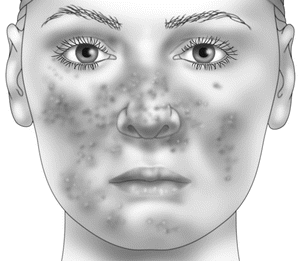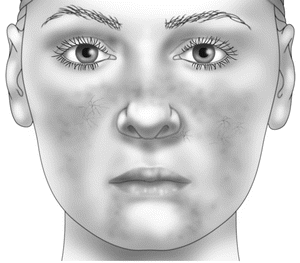, Toral Patel3, 4, Neill T. Peters3, 2 and Sarah Kasprowicz5
(1)
Northwestern University Feinberg School of Medicine, Chicago, IL, USA
(2)
Medical Dermatology Associates of Chicago, Chicago, IL, USA
(3)
Instructor of Clinical Dermatology, Northwestern University Feinberg School of Medicine, Chicago, IL, USA
(4)
D&A Dermatology, Chicago, IL, USA
(5)
NorthShore University HealthSystem, University of Chicago, Pritzker School of Medicine, Chicago, IL, USA
Keywords
NicotinamideAzelaic acidChrysanthemum extractQuassia extractIntroduction
It is estimated that rosacea affects 16 million people in the US. Rosacea is a chronic inflammatory skin disorder characterized by increased cutaneous sensitivity and inflammation that is most commonly limited to the central part of the face. Rosacea typically affects adults in the third decade and it is predominantly seen in women. Clinical features may include: erythema, papules and pustules, facial flushing, telangiectasias and/or an associated ocular disease. Typically, rosacea is classified into four sub-types: Erythematotelangiectatic, papulopustular, phymatous and ocular (Emer et al. 2011). Disease exacerbation has been associated with a variety of triggers, including but not limited to: caffeine, exercise, UV radiation, stress, microbial colonization of the face, spicy food, alcohol, and heat.
In the last decade it has become clear that little is known about the pathophysiology of rosacea. Recent studies suggest that rosacea initially occurs in individuals when inappropriate innate immune responses to environmental stimuli lead to inflammation and vascular abnormalities (Steinhoff et al. 2013). As the innate immune system plays a key role in the immunologic skin barrier, agents that promote a competent barrier are likely to be beneficial adjuncts in the treatment of this disease.
One of the most difficult aspects of rosacea to treat is the associated erythema. Few conventional therapies adequately target the background erythema or flushing, while papules and pustules also leave residual redness behind, once treated (Layton and Thiboutot 2013). Given the dearth of conventional treatment options for the erythema of rosacea, botanically-derived ingredients can be looked at to fill this void. As with other areas, there is a paucity of data for integrative treatments for rosacea, with few randomized controlled trials. Below we detail several and then focus on secondary considerations that hold potential for benefit by improving the barrier and targeting inflammation.
Clinical Considerations
Top Considerations
See Table 6.1.
Table 6.1.
Top considerations.
Treatment | How administered | Notes |
|---|---|---|
Topical nicotinamide | Applied topically | Safe, generally well-tolerated |
Azelaic acid | Applied once or twice daily | Safe, generally well-tolerated |
Secondary Considerations
See Table 6.2.
Table 6.2.
Secondary considerations.
Treatment | How administered | Notes |
|---|---|---|
Chrysanthemum indicum | Applied topically | Difficult to acquire |
Quassia extract | Applied topically | Very limited in vivo work |
Top Considerations
Nicotinamide
Nicotinamide is also known as niacinamide and nicotinic acid. It is a water-soluble vitamin found in meat, fish and wheat. It does not have the same pharmacologic effects of niacin, and therefore it does not cause a flushing reaction. Nicotinamide acts as an anti-oxidant and has anti-inflammatory properties, skin-lightening properties, and can decrease the production of sebum (Niren 2006). Topical application of nicotinamide has a stabilizing effect on epidermal barrier function and reduces transepidermal water loss (Draelos et al. 2005). In addition, nicotinamide increases protein synthesis and potentiates the differentiation of keratinocytes making it a natural alternative to improve the skin integrity (Niren 2006).
Evidence for Nicotinamide
1.
Niacinamide-containing facial moisturizer improves skin barrier and benefits subjects with rosacea. Draelos Z, Ertel K, Berge C. Cutis. 2005 Aug;76(2):135–41.
Stay updated, free articles. Join our Telegram channel

Full access? Get Clinical Tree










